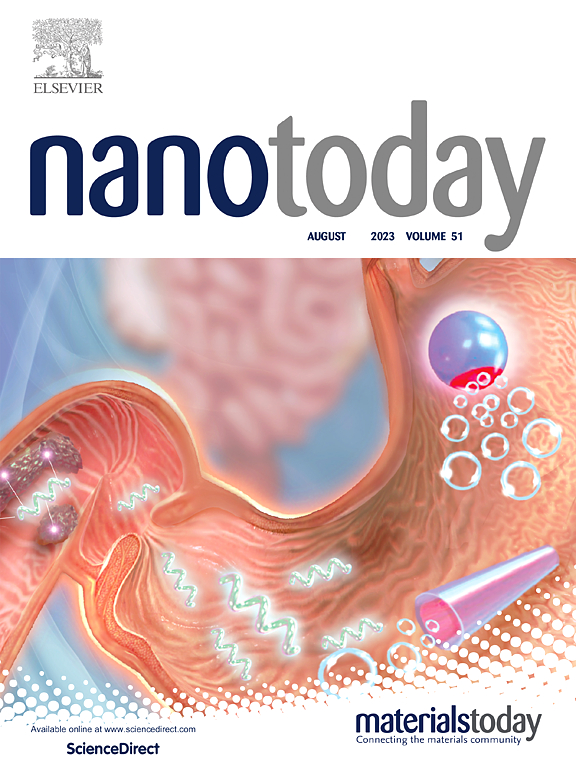Nanozyme engineered ROS-tolerant cysteine active-site for upstream deubiquitylation therapy of inflammatory bowel disease
IF 13.2
1区 材料科学
Q1 CHEMISTRY, MULTIDISCIPLINARY
引用次数: 0
Abstract
Deubiquitinase (DUB)-based upstream regulation of inflammatory pathway has emerged as a promising strategy for inflammatory bowel disease (IBD) compared to clinical biological therapies that block downstream inflammatory mediators. Unfortunately, excessive reactive oxygen species (ROS) in the inflammatory microenvironment usually induces irreversible oxidation of the cysteine active-site of therapeutic DUB, resulting in the rapid fading of deubiquitylation activity and inferior anti-inflammatory efficacy. Herein, a redox active nanozyme boosted deubiquitylation strategy based on the natural-artificial dual catalytic nanodrug (NADCN) is designed for protecting the vulnerable catalytic active center of anti-inflammatory DUB. Benefiting from the nanozyme-enabled protection of DUB’s cysteine active-site, the NADCN exhibits far superior anti-inflammatory activity to that of its counterparts based on the conventional delivery system. Moreover, the redox nanozyme in NADCN confers efficient modulation of the oxidative and hypoxia inflammatory microenvironment, further unleashing the potential of DUB for treatment of IBD. Therefore, the NADCN opens a new avenue to protect the cysteine active-site of therapeutic DUB, providing an attractive opportunity for developing ROS-tolerant deubiquitylation therapy.
纳米酶工程ros耐受半胱氨酸活性位点用于炎性肠病上游去泛素化治疗
与阻断下游炎症介质的临床生物疗法相比,基于去泛素酶(DUB)的炎症途径上游调控已成为治疗炎症性肠病(IBD)的一种有前景的策略。不幸的是,炎症微环境中过多的活性氧(ROS)通常会引起治疗性DUB的半胱氨酸活性位点的不可逆氧化,导致去泛素化活性迅速消退,抗炎效果下降。本文设计了一种基于天然-人工双催化纳米药物(NADCN)的氧化还原活性纳米酶促进去泛素化策略,以保护抗炎DUB的易损催化活性中心。得益于纳米酶对DUB的半胱氨酸活性位点的保护,NADCN表现出远优于基于传统给药系统的NADCN的抗炎活性。此外,NADCN中的氧化还原纳米酶可以有效调节氧化和缺氧炎症微环境,进一步释放DUB治疗IBD的潜力。因此,NADCN为保护治疗性DUB的半胱氨酸活性位点开辟了新的途径,为开发ros耐受性去泛素化治疗提供了有吸引力的机会。
本文章由计算机程序翻译,如有差异,请以英文原文为准。
求助全文
约1分钟内获得全文
求助全文
来源期刊

Nano Today
工程技术-材料科学:综合
CiteScore
21.50
自引率
3.40%
发文量
305
审稿时长
40 days
期刊介绍:
Nano Today is a journal dedicated to publishing influential and innovative work in the field of nanoscience and technology. It covers a wide range of subject areas including biomaterials, materials chemistry, materials science, chemistry, bioengineering, biochemistry, genetics and molecular biology, engineering, and nanotechnology. The journal considers articles that inform readers about the latest research, breakthroughs, and topical issues in these fields. It provides comprehensive coverage through a mixture of peer-reviewed articles, research news, and information on key developments. Nano Today is abstracted and indexed in Science Citation Index, Ei Compendex, Embase, Scopus, and INSPEC.
 求助内容:
求助内容: 应助结果提醒方式:
应助结果提醒方式:


